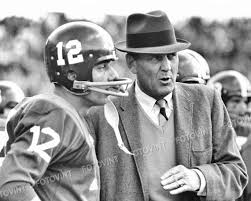Bear Bryant is considered by many to be one of the greatest college football coaches of all time, and best known as the head coach of the University of Alabama football team, the Alabama Crimson Tide, from 1958 to 1982. During his 25-year tenure as Alabama’s head coach, he amassed… Read full Article…

Bear Bryant: The Legendary Architect of Alabama Football Dominance
Paul “Bear” Bryant is a name etched in the annals of college football history, revered not just for his monumental achievements on the field but also for the culture and legacy he instilled in the sport. Widely considered one of the greatest college football coaches of all time, Bryant’s impact on the University of Alabama and college football at large remains both profound and enduring. Over a coaching career that spanned nearly four decades, Bryant became a symbol of excellence, grit, and relentless drive for success.
Early Life and Playing Career
Born on September 11, 1913, in Moro Bottom, Arkansas, Paul William Bryant earned the nickname “Bear” at the age of 13 after wrestling a muzzled bear at a carnival. That fearless tenacity would come to define his character both on and off the football field. He went on to play college football at the University of Alabama from 1932 to 1935 under coach Frank Thomas. Playing as an end, Bryant was a part of the 1934 team that went undefeated and won the Rose Bowl, setting the stage for his long association with Alabama.
Rise Through the Coaching Ranks
After his playing days ended, Bryant began his coaching career as an assistant under Frank Thomas at Alabama. World War II interrupted his progression, and he served in the U.S. Navy during the conflict. Upon his return, Bryant resumed coaching, landing head coaching roles at Maryland (1945), Kentucky (1946–1953), and Texas A&M (1954–1957). At each stop, he quickly turned underperforming programs into contenders.
His tenure at Texas A&M, in particular, became legendary thanks to his infamous 1954 “Junction Boys” training camp. In brutal Texas heat, Bryant pushed his players to their physical and mental limits. Though controversial, this period helped mold a tough, disciplined team that would become the Southwest Conference champion in 1956.
The Alabama Years: 1958–1982
In 1958, Bryant returned to his alma mater as the head coach of the Alabama Crimson Tide. The program was struggling at the time, having posted four straight losing seasons. Within a few years, Bryant resurrected the team, instilling discipline, toughness, and a relentless desire to win.
Bryant’s teams quickly returned to prominence, winning the national championship in 1961, only his fourth year as head coach. Over the next two decades, Alabama became a perennial powerhouse. Under Bryant’s leadership, the Crimson Tide won six national championships (1961, 1964, 1965, 1973, 1978, and 1979) and 13 Southeastern Conference (SEC) titles.
His ability to adapt to the evolving nature of the game was key to his long-term success. In the early years, his teams dominated with a strong running game and a staunch defense. Later, recognizing the rise of the wishbone offense, Bryant adopted the formation and continued to win with it, demonstrating his tactical flexibility.
Legacy and Achievements
By the time Bryant retired after the 1982 season, he had amassed 323 victories, a record at the time for a major college football coach. He was named National Coach of the Year three times and SEC Coach of the Year 12 times.
Perhaps more important than the numbers was the culture he cultivated. He demanded discipline, accountability, and excellence from his players. Many former athletes who played under Bryant have spoken about how his teachings carried over into their lives well beyond football, influencing them as leaders, fathers, and professionals.
Bryant’s signature houndstooth hat became an iconic symbol, and his stoic demeanor on the sidelines reflected a deep commitment to his craft. Yet those close to him described a man who cared deeply for his players and often went to great lengths to help them succeed off the field.
His coaching tree is another testament to his influence. Dozens of assistant coaches and former players under Bryant went on to have successful coaching careers, spreading his philosophy across the country.
A Lasting Impact
Bear Bryant passed away on January 26, 1983, just weeks after coaching his final game in the Liberty Bowl—a victory over Illinois. His death was mourned across the nation, with thousands attending his funeral and tributes pouring in from players, coaches, and fans.
In 1986, the Paul W. Bryant Museum was opened on the University of Alabama campus, dedicated to preserving his legacy and the history of Alabama football. The university also established the Paul W. Bryant Scholarship Fund to support student-athletes academically.
Today, Bryant remains a towering figure in the world of sports. His impact is not only measured by wins and championships but by the values he instilled in generations of players and coaches. His legacy lives on every fall Saturday when the Crimson Tide take the field, still guided by the standard of excellence he set decades ago.
In an era where the pressure to win often overshadows the importance of character, Bear Bryant stood as a man who demanded both. For Alabama fans and college football purists alike, he will always be more than a coach—he is a legend, an icon, and a timeless symbol of football greatness.

